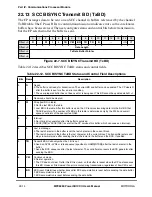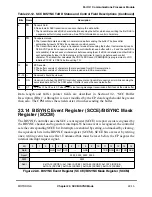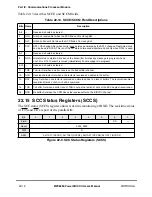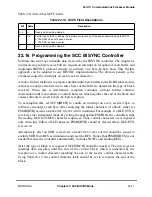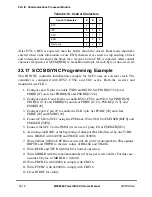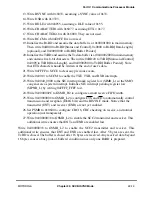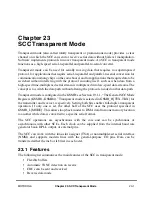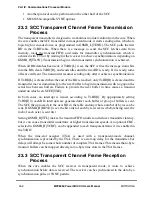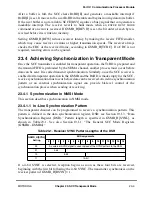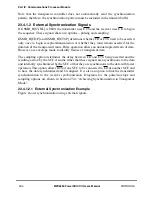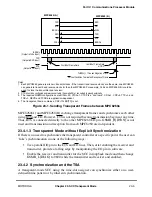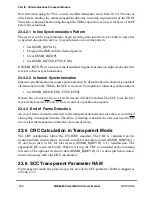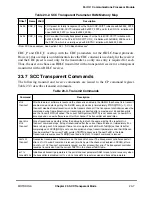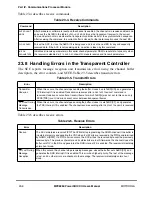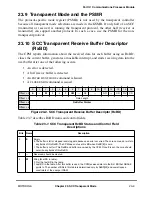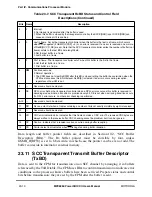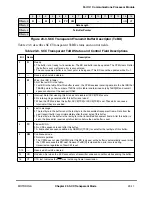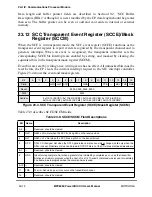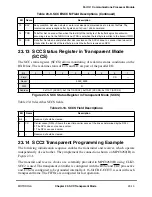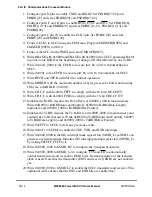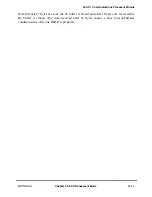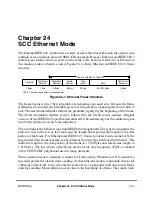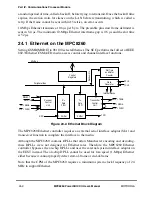
MOTOROLA
Chapter 23. SCC Transparent Mode
23-3
Part IV. Communications Processor Module
After a buffer is full, the SCC clears RxBD[E] and generates a maskable interrupt if
RxBD[I] is set. It moves to the next RxBD in the table and begins moving data to its buffer.
If the next buffer is not available, SCCE[BSY] signiÞes a busy signal that can generate a
maskable interrupt. The receiver reverts to hunt mode when an
ENTER
HUNT
MODE
command or an error is received. If GSMR_H[REVD] is set, the bit order of each byte is
reversed before it is written to memory.
Setting GSMR_H[RFW] reduces receiver latency by making the receive FIFO smaller,
which may cause receiver overruns at higher transmission speeds. The receiver always
checks the CRC of the received frame, according to GSMR_H[TCRC]. If a CRC is not
required, resulting errors can be ignored.
23.4 Achieving Synchronization in Transparent Mode
Once the SCC transmitter is enabled for transparent operation, the TxBD is prepared and
the transmit FIFO is preloaded by the SDMA channel, another process must occur before
data can be sent. It is called transmit synchronization. Similarly, once the SCC receiver is
enabled for transparent operation in the GSMR and the RxBD is made empty for the SCC,
receive synchronization must occur before data can be received. An in-line synchronization
pattern or an external synchronization signal can provide bit-level control of the
synchronization process when sending or receiving.
23.4.1 Synchronization in NMSI Mode
This section describes synchronization in NMSI mode.
23.4.1.1 In-Line Synchronization Pattern
The transparent channel can be programmed to receive a synchronization pattern. This
pattern is deÞned in the data synchronization register, DSR; see Section 19.1.3, ÒData
Synchronization Register (DSR).Ó Pattern length is speciÞed in GSMR_H[SYNL], as
shown in Table 23-1. See also Section 19.1.1, ÒThe General SCC Mode Registers
(GSMR1ÐGSMR4)
.Ó
If a 4-bit SYNC is selected, reception begins as soon as these four bits are received,
beginning with the Þrst bit following the 4-bit SYNC. The transmitter synchronizes on the
receiver pattern if GSMR_H[RSYN] = 1.
Table 23-1. Receiver SYNC Pattern Lengths of the DSR
GSMR_H[SYNL]
Setting
Bit Assignments
0
1
2
3
4
5
6
7
8
9
10
11
12
13
14
15
00
An external SYNC signal is used instead of the SYNC pattern in the DSR.
01
4-bit
10
8-bit
11
16-bit
Summary of Contents for MPC8260 PowerQUICC II
Page 1: ...MPC8260UM D 4 1999 Rev 0 MPC8260 PowerQUICC II UserÕs Manual ª ª ...
Page 66: ...lxvi MPC8260 PowerQUICC II UserÕs Manual MOTOROLA ...
Page 88: ...1 18 MPC8260 PowerQUICC II UserÕs Manual MOTOROLA Part I Overview ...
Page 120: ...2 32 MPC8260 PowerQUICC II UserÕs Manual MOTOROLA Part I Overview ...
Page 138: ...Part II iv MPC8260 PowerQUICC II UserÕs Manual MOTOROLA Part II Configuration and Reset ...
Page 184: ...4 46 MPC8260 PowerQUICC II UserÕs Manual MOTOROLA Part II ConÞguration and Reset ...
Page 202: ...Part III vi MPC8260 PowerQUICC II UserÕs Manual MOTOROLA Part III The Hardware Interface ...
Page 266: ...8 34 MPC8260 PowerQUICC II UserÕs Manual MOTOROLA Part III The Hardware Interface ...
Page 382: ...10 106 MPC8260 PowerQUICC II UserÕs Manual MOTOROLA Part III The Hardware Interface ...
Page 392: ...11 10 MPC8260 PowerQUICC II UserÕs Manual MOTOROLA Part III The Hardware Interface ...
Page 430: ...Part IV viii MOTOROLA Part IV Communications Processor Module ...
Page 490: ...14 36 MPC8260 PowerQUICC II UserÕs Manual MOTOROLA Part IV Communications Processor Module ...
Page 524: ...17 10 MPC8260 PowerQUICC II UserÕs Manual MOTOROLA Part IV Communications Processor Module ...
Page 556: ...18 32 MPC8260 PowerQUICC II UserÕs Manual MOTOROLA Part IV Communications Processor Module ...
Page 584: ...19 28 MPC8260 PowerQUICC II UserÕs Manual MOTOROLA Part IV Communications Processor Module ...
Page 632: ...21 24 MPC8260 PowerQUICC II UserÕs Manual MOTOROLA Part IV Communications Processor Module ...
Page 652: ...22 20 MPC8260 PowerQUICC II UserÕs Manual MOTOROLA Part IV Communications Processor Module ...
Page 668: ...23 16 MPC8260 PowerQUICC II UserÕs Manual MOTOROLA Part IV Communications Processor Module ...
Page 758: ...27 28 MPC8260 PowerQUICC II UserÕs Manual MOTOROLA Part IV Communications Processor Module ...
Page 780: ...28 22 MPC8260 PowerQUICC II UserÕs Manual MOTOROLA Part IV Communications Processor Module ...
Page 874: ...29 94 MPC8260 PowerQUICC II UserÕs Manual MOTOROLA Part IV Communications Processor Module ...
Page 920: ...31 18 MPC8260 PowerQUICC II UserÕs Manual MOTOROLA Part IV Communications Processor Module ...
Page 980: ...A 4 MPC8260 PowerQUICC II UserÕs Manual MOTOROLA Appendixes ...
Page 1002: ...Index 22 MPC8260 PowerQUICC II UserÕs Manual MOTOROLA INDEX ...
Page 1006: ......






